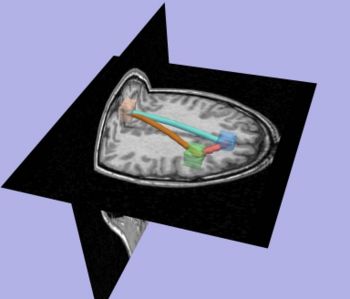Difference between revisions of "Projects:ConnectingRegionsOfFunctionalActivation"
(No difference)
| |
Revision as of 03:49, 21 August 2007
Home < Projects:ConnectingRegionsOfFunctionalActivationObjectives:
To measure, and compare between groups, anatomical connectivity between regions demonstrating functional activation during experiment requiring selection and conflict monitoring.
Key Investigators:
- BWH: Marek Kubicki, Lida Ungar, Marc Niethammer, Martha Shenton, Carl-Fredrik Westin
Progress:
We collected preliminary data using an application of the “optimal path analysis”. In this analysis, we extracted group fMRI activation due to the Stroop effect (attentional experiment where incongruent color, in which the word is written, competes with name of the color itself, activating areas responding to conflict monitoring and selection) separately for controls and schizophrenics. This resulted in three clusters of activation, one in the right Dorsolateral Prefrontal Cortex, a second in the Anterior Cingulate Gyrus, and a third in the Medial Parietal Lobe. In the next step, we placed activation clusters in each individual space, by reversing normalization parameters used during fMRI analysis. Finally, EPI fMRI scans were co-registered to DTI scans, and the same registration parameters were applied to activation maps (fMRI results).
Regions of activation were used as start and destination points for optimal path analysis, which resulted in three separate paths of optimal connectivity for each subject. The probability of the connections were then calculated for each path and each subject, and compared between groups. In our preliminary analysis we included 10 control subjects and 10 chronic schizophrenics. Our results demonstrated a relationship between Stroop Effect fMRI activation in the medial parietal area and optimal path connectivity between parietal and cingulate activation sites in schizophrenics (rho=-0.56; p=0.047), which was not observed in controls. These findings suggest that decreased connectivity may result in schizophrenics relying more on posterior parts of the executive attentional network during performance of the Stroop task.
